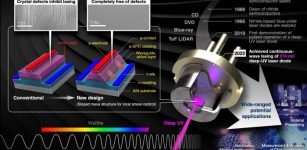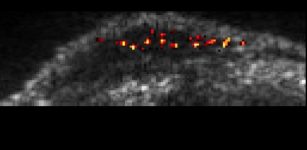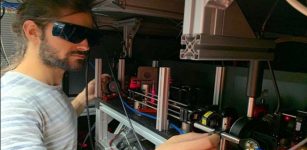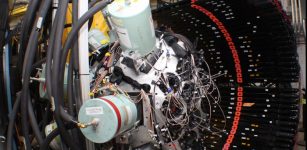Single Quantum Vibration Under Ordinary Conditions – Observed
Eddie Gonzales Jr. – MessageToEagle.com – When a guitar string is plucked, it vibrates as any vibrating object would, rising and falling like a wave, as the laws of classical physics predict. But under the laws of quantum mechanics, which describe the way physics works at the atomic scale, vibrations should behave not only as waves but also as particles. The same guitar string, when observed at a quantum level, should vibrate as individual units of energy known as phonons.
Now scientists at MIT and the Swiss Federal Institute of Technology have for the first time created and observed a single phonon in a common material at room temperature.
 MIT researchers detect a single quantum vibration within a diamond sample (shown here) at room temperature. Image: Sabine Galland
MIT researchers detect a single quantum vibration within a diamond sample (shown here) at room temperature. Image: Sabine Galland
For the new study, the team looked to a diamond as a test subject. In diamond, phonons naturally operate at high frequencies, of tens of terahertz — so high that, at room temperature, the energy of a single phonon is higher than the surrounding thermal energy.
Until now, single phonons have only been observed at ultracold temperatures and in precisely engineered, microscopic materials that researchers must probe in a vacuum. In contrast, the team has created and observed single phonons in a piece of diamond sitting in open air at room temperature.
“There is a dichotomy between our daily experience of what a vibration is — a wave — and what quantum mechanics tells us it must be — a particle,” Vivishek Sudhir, a postdoc in MIT’s Kavli Institute for Astrophysics and Space Research, said in a press release.
“Our experiment, because it is conducted at very tangible conditions, breaks this tension between our daily experience and what physics tells us must be the case.”
The technique the team developed can now be used to probe other common materials for quantum vibrations. This may help researchers characterize the atomic processes in solar cells, as well as identify why certain materials are superconducting at high temperatures.
“What our work means is that we now have access to a much wider palette of systems to choose from,” says Sudhir, one of the paper’s lead authors.
Read more – here
Written by Eddie Gonzales Jr. – MessageToEagle.com Staff










